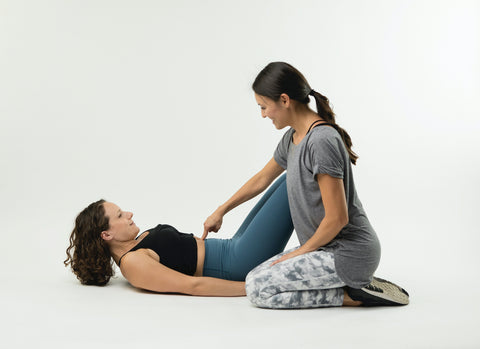
Pelvic Floor Physical Therapy
Sara Reardon PT, DPT, WCS is doctor of physical therapy and board-certified women’s health clinical specialist who graduated from Washington University in St. Louis. She is the owner of NOLA Pelvic Health, a pelvic floor physical therapy clinic in New Orleans. You can follow her on Instagram and read through her wealth of information on women’s pelvic health, pregnancy and postpartum on her website.

What is Pelvic Floor Physical Therapy? How do you know if you need it?
“I did not know there was physical therapy for THAT!”
This is one of the most common responses I get when I tell people what I do. I am a pelvic floor physical therapist. Physical therapists treat muscles and tissues and nerves in the body. I specialize in treating the muscles and tissues in the pelvic region of the body, which play an important role in peeing, pooping, supporting your organs, having sex, and birthing a baby.
The pelvic floor muscles sit like a basket at the base of your pelvis. These muscles stay contracted throughout the day to support your organs and hold in pee and poop. When you go to the restroom, you can relax these muscles to empty your bladder or bowels. Relaxation of these muscles is also essential for vaginal intercourse and childbirth.
Oftentimes, you won’t have to think about these muscles if all is working well. But just like any other muscles in your body, your pelvic floor muscles can get tense, weak, or not coordinate properly which can lead to bladder or bowel problems or pain.
If your pelvic floor muscles are tense, you may experience vaginal pain, tailbone pain, painful intercourse, or incomplete emptying of your bladder and bowels.
If your pelvic floor muscles are too weak you may experience urinary leakage, decreased support of your pelvic organs, heaviness, pressure, or extreme urgency to get to the bathroom in time.
Pelvic floor issues may start after a significant event like pregnancy or childbirth, menopause, or starting a new activity or medication. Or they may happen gradually over time and you may believe them to be “normal” until they get to the point where they significantly affect your life. Some individuals may think little leaks with laughing or sneezing are normal or that sex after childbirth is supposed to be painful, that we just have new bodies after having babies and nothing can be done. Although common, these experiences are not normal.

Enter pelvic floor physical therapy. (Actually it should enter much sooner than this but oftentimes this is when most patients come our way). In a pelvic floor physical therapy session, I will gather some information and perform an assessment by checking out your posture, pelvic alignment, and abdominal wall for tenderness/trigger points, diastasis recti/abdominal separation, or scar tissue restriction from a surgery. Then I perform an internal pelvic floor muscle assessment through the vagina to check strength, tone and tension of your pelvic floor. It’s somewhat similar to when you see your gynecologist but no scary speculums! After the assessment, I chat with you about what I found, give you some tips and exercises to start, and plan to see you again soon. See? Just like regular physical therapy, but for your pelvic floor.
Pelvic Floor PTs like myself do not just treat pelvic floor conditions, we also work with patients on how to prevent them. I spend a lot of time on education with my patients addressing topics that are rarely discussed yet so important to our daily lives: the proper way to poop, pain-free sex, leaking when you sneeze (not normal), kegels (they’re not the right exercise for everyone!), and teaching pregnant women how to push properly during childbirth and offering guidance on postpartum recovery.
We learn very little about pelvic health and prevention of pelvic floor problems in culture. Outside of “do your kegels,” these issues are just not talked about often, leading one to think that the only options are medication, surgery or “just dealing with it.” Pelvic floor physical therapy is an option to help treat these common but not normal conditions.

My goal as an advocate of women’s health reform and as a pelvic floor physical therapist is to change the way we care for women and their pelvic floors. Pelvic floor issues are not just “part of being a woman” and they are treatable. Talking openly about these issues is not about shock value. It’s about making sure we’re aware of health issues that are addressable, that when addressed can help us live fuller, happier and more productive lives. So, does your pelvic floor need PT?
A great option for those unable to see a PT in person is our online mini courses and my Power Pregnancy Guide. While these don’t replace seeing a PT in person, they are great alternatives. The Power Pregnancy Guide combines fitness and pelvic floor therapy to give you weekly workouts from weeks 8-40 of your pregnancy. We go over all the principles to keep your core and pelvic floor strong during your pregnancy and prepared for birth.
My online mini courses cover: pelvic floor prep for childbirth, vaginal birth postpartum recovery, cesarean birth prep and recovery, overcoming painful sex, identify and recover diastasis recti, and easing constipation. They’re great solutions for those with any of the aforementioned specific issues, which are the most common ailments I see in my practice.
For more pelvic floor PT tips, follow along on Instagram.
No comments







0 comments